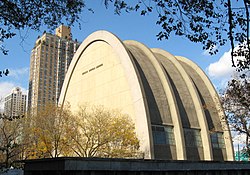Ely Jacques Kahn
Ely Jacques Kahn | |
|---|---|
Ely Jacques Kahn, Jr. Olivia Kahn | |
| Relatives | Rena Rosenthal (sister) |
Ely Jacques Kahn (June 1, 1884 – September 5, 1972) was an American commercial architect who designed numerous skyscrapers in New York City in the twentieth century.[1] In addition to buildings intended for commercial use, Kahn's designs ranged throughout the possibilities of architectural programs, including facilities for the film industry. Many of the buildings he designed under the 1916 Zoning Resolution feature architectural setbacks[2] to keep the building profitably close to its permitted "envelope"; these have been likened to the stepped form of the Tower of Babel.[3][4] Kahn is also known for his guidance to author Ayn Rand.
Life and career
Kahn was born in New York, the only son of a prosperous Austrian and French-American Jewish family. His sister
Kahn's partnership with
As research for The Fountainhead, author Ayn Rand worked in Kahn's office,[11] where Kahn arranged for her to meet Frank Lloyd Wright.[12] Kahn, who had taken full control of the practice of Kahn & Buchman in 1930, as Ely Jacques Kahn Architects, produced some commercial skyscrapers that combined traditional massing with a skin pared of all details, such as the 42-storey Continental Building (1931) at Broadway and West 41st Street.[13]

In 1940, he formed a partnership with
Kahn's work just after
Although Kahn retired some years earlier, the firm of Kahn & Jacobs lasted until 1973, the year after Kahn's death.[20]
Kahn's extensive architectural drawings and papers, including materials from the firms Buchman & Kahn and Kahn & Jacobs, are held in the Department of Drawings & Archives at the Avery Architectural and Fine Arts Library at Columbia University.
References
Notes
- ISBN 0-393-73114-6
- ISBN 0-910413-11-8
- ISBN 0-8112-1609-8.
- ISBN 0-88125-808-3
- OCLC 13860977.
- ^ "Kahn & Jacobs architectural drawings and records, 1893-1965". Columbia University Libraries. Retrieved July 27, 2020.
- ^ "Emelyn Northway, Ely Kahn IV". The New York Times. August 9, 2015.
- ^ a b "745 Fifth Avenue" on The City Review website
- ISBN 1-885254-00-8
- ISBN 0-394-50595-6
- ^ Mimi Reisel Gladstein, The New Ayn Rand Companion, Greenwood, 1999, p. 41, ISBN 0-313-30321-5
- ^ Stern 2006, p. 179
- ^ The Continental Building[dead link]
- ISBN 0-226-03698-7
- ^ "This bold work of 'industrial architecture' has not been matched in New York for bald functional and esthetic logic." AIA Guide to New York City (1st ed.) New York: Macmillan, 1968. p.181
- ^ "New York Stock Exchange Annex" on Emporis
- ^ Shulman, Ken. "Restoring the Soul" Archived July 6, 2008, at the Wayback Machine Metropolis (October 2000)
- ^ Kahn, Ely Jacques. "Creating a Modern Synagogue Style: No More Copying", Commentary (June 1947)
- ISBN 0-300-05991-4
- ^ Stern 2006, p. 56
External links
- Ely Jacques Kahn papers, 1906-1986, (bulk 1906-1972).Held by the Department of Drawings & Archives, Avery Architectural & Fine Arts Library, Columbia University.
- Kahn & Jacobs architectural drawings and papers, circa 1893-1965, (bulk circa 1893-1950) held in the Department of Drawings & Archives Avery Architectural and Fine Arts Library
- Hohenems Genealogy Database
